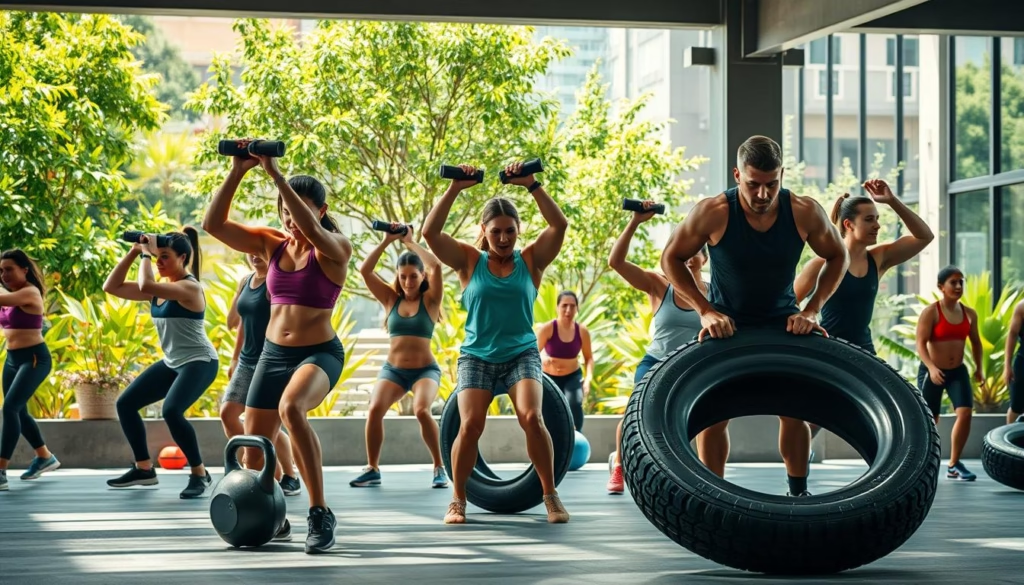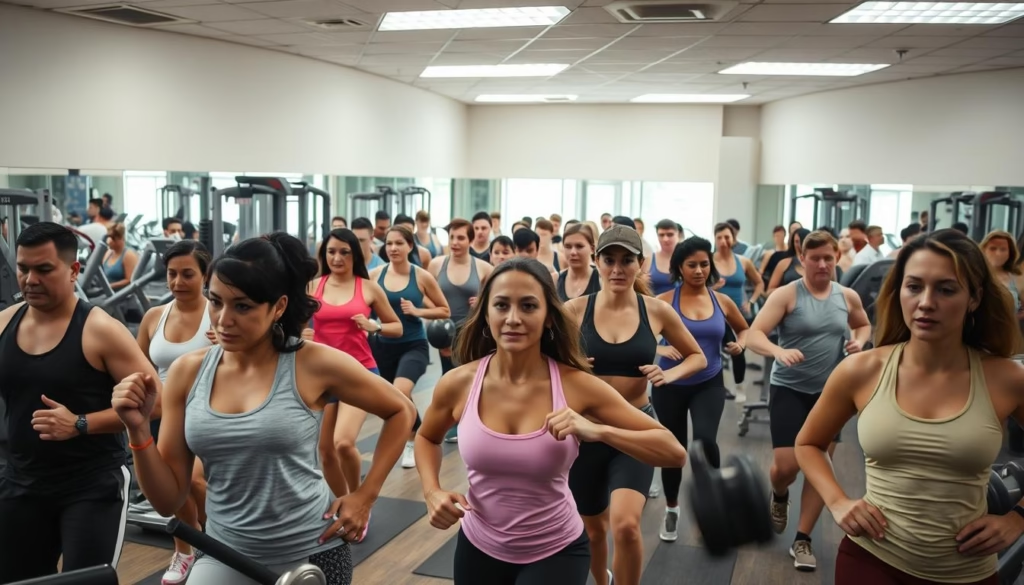I’ve always struggled with choosing between functional fitness and traditional strength training. Should I aim for strong muscles or better mobility and balance? Both methods have their benefits, but understanding their differences is key.
Traditional strength training focuses on lifting heavy weights and building muscle1. But functional fitness is gaining popularity. It aims to make everyday movements easier and more efficient2. Functional training works multiple muscles at once, preparing your body for real-life activities.
Key Takeaways
- Functional fitness improves balance, coordination, and joint mobility. Traditional fitness focuses on muscle growth and strength.
- Functional training uses bodyweight, kettlebells, and more to mimic real-life movements. Traditional fitness relies on machines and free weights.
- Functional fitness prevents injuries, saves time, and applies to daily life. Traditional fitness aims for maximum muscle and strength.
- Both methods have their benefits. It’s important to choose based on your goals and lifestyle.
- Mixing functional and traditional fitness can create a balanced, lasting fitness plan.
Understanding Functional Fitness
Functional fitness is a way to exercise that makes you better at everyday tasks3. It’s different from traditional strength training because it uses exercises that work many muscles at once4. This helps your body get ready for the things you do every day.
Definition of Functional Fitness
Functional fitness is about getting better at doing things you do every day5. It uses exercises that work many muscles at once. This improves your strength, flexibility, balance, and coordination3. It helps you handle the challenges of daily life better.
Key Principles of Functional Fitness
- Emphasis on bodyweight exercises and natural movement patterns3
- Integration of strength, flexibility, and endurance training5
- Utilization of versatile equipment like kettlebells, resistance bands, and medicine balls3
- Emphasis on core stability, balance, and coordination5
- Incorporation of compound exercises that engage multiple muscle groups4
By following these principles, functional fitness aims to make you more physically capable for daily life5.
“Functional fitness is about training your body to perform the movements and activities you do in daily life, not just lifting weights for the sake of building muscle.”
Exploring Traditional Fitness
Traditional fitness, also known as strength or resistance training, is a classic way to build muscle. It focuses on exercises that target specific muscles. The goal is to boost strength training and muscle isolation6.
What is Traditional Fitness?
At its heart, traditional fitness is about progressive overload. This means slowly increasing the weight or intensity of workouts. It helps muscles grow and get stronger over time7.
This method uses exercises like bench presses and bicep curls. These exercises target specific muscles for growth and strength8.
Common Practices in Traditional Fitness
Bodybuilders use heavy weights and bodyweight exercises to build muscle size8. Powerlifters focus on strength training for competitions8. They do exercises like squats and deadlifts to work multiple muscles at once8.
Traditional strength training uses machines, barbells, and dumbbells7. It aims to lift the heaviest weights possible for muscle growth7. Success is shown by one-rep max lifts, which measure raw strength and power7.
“Traditional strength training leads to increased lean muscle mass, heightened bone density, elevated metabolism, and fat loss.”7
While traditional fitness is great for muscle building, adding functional training is key. It improves overall fitness and helps prevent injuries7.
Comparing Goals: Why Train?
Fitness goals can differ a lot. Some focus on everyday movements, while others aim for athletic performance. Knowing your goals helps pick the right training method.
Functional Fitness Goals
Functional fitness aims to boost everyday movements. Its main goals are:9
- Enhancing balance, coordination, and agility for easier daily tasks.
- Improving strength and power for more efficient real-world tasks.
- Better posture, stability, and core engagement for daily life.
- Lowering injury risk by training for common activities.
Traditional Fitness Goals
Traditional fitness focuses on physical attributes and athletic skills. Its main goals are:910
- Building muscle size and strength with specific exercises.
- Boosting cardiovascular endurance and health.
- Enhancing sports-specific skills and athletic abilities.
- Reaching aesthetic goals like a more muscular or lean body.
Your fitness goals decide between functional or traditional training10.
“The key to choosing the right fitness approach is understanding your personal goals and the specific benefits each method offers.”
The Role of Movement in Functional Training
Functional training focuses on movements like squatting, lifting, pushing, and pulling11. It uses compound exercises that work many muscles at once. This improves body coordination and efficiency11. Traditional fitness often uses isolation exercises that target specific muscles11.
Everyday Movements
Functional training includes movements like standing up from a chair or carrying groceries11. These movements work many muscles, boosting strength, balance, and coordination11. Adding these movements to your workouts prepares your body for daily life.
Compound vs. Isolation Exercises
Traditional strength training isolates specific muscles12. But functional training focuses on compound exercises that work many muscles at once11. Exercises like squats and push-ups mimic real-life movements11. Isolation exercises, like bicep curls, target single muscles and don’t reflect how we move naturally11.
“Functional strength training is distinguished by its focus on performance and functionality rather than just muscle size and strength, setting it apart from traditional strength training.”11
Mixing compound and isolation exercises in your routine balances strength and functionality12. Understanding movement patterns in functional training helps create a more effective fitness plan.
Equipment Used in Functional vs. Traditional Fitness
Functional and traditional fitness use different types of equipment. Functional fitness uses simple, versatile tools for full-body movements. Traditional fitness uses specialized machines and weights for specific muscle groups.
Functional Fitness Equipment
Functional fitness focuses on tools that mimic real-life movements. It includes bodyweight exercises, resistance bands, stability balls, and kettlebells. These help improve strength, stability, and mobility for daily tasks13.
Functional training machines, like suspension trainers and TRX systems, also fit into this category. They challenge the body to work against gravity and maintain proper form14.
Traditional Fitness Equipment
Traditional fitness uses specialized gym equipment like weight machines, barbells, and dumbbells15. These tools target specific muscles for strength training15. While effective for muscle growth, they may not improve real-world movements as much15.
| Functional Fitness Equipment | Traditional Fitness Equipment |
|---|---|
|
|
Choosing between functional and traditional equipment depends on your fitness goals and lifestyle13. Functional equipment focuses on overall conditioning and real-world use. Traditional equipment targets specific muscle strength and size15.
Mixing both types can create a balanced fitness routine. It meets your unique needs and goals.
“Functional training strengthens ligaments around muscles to prevent strain and injuries.”15
Benefits of Functional Fitness
Functional fitness is more than just building muscle. It improves your daily life in many ways. It helps you move better and reduces injuries16.
Enhancing Daily Life Activities
Functional fitness makes you more mobile and flexible. It strengthens your core and lower body16. This makes simple tasks like climbing stairs or gardening easier16.
Injury Prevention
Functional fitness also prevents injuries. It prepares your body for daily activities17. This reduces the risk of back pain, shoulder issues, or knee problems17.
Do functional exercises two to three times a week for 30 minutes18. Do them before traditional strength training if you do both in one day18. Start with light weights and fewer reps to avoid injuries, then increase18.

Functional fitness improves your daily life and reduces injuries. It helps with pain, mobility, and moving easily17.
“Functional fitness is not just about building muscle or achieving a specific physique. It offers a wide range of benefits that can enhance your everyday life.”
Advantages of Traditional Fitness
Traditional fitness is great for building muscle strength and improving heart health. It uses free weights, machines, and bodyweight exercises. These help grow muscles and increase body strength19. It also improves muscle shape, bone density, and metabolism, helping with weight management and fat loss19.
Building Muscle Strength
Traditional strength training lets you track progress and set goals clearly. Exercises like squats, deadlifts, and bench press work many muscles at once. This boosts strength19. Strength training equipment gets high ratings, showing it’s effective and reliable20.
Cardiovascular Endurance
Traditional fitness also boosts heart health. Adding cardio like running or cycling to your routine improves endurance and heart health19. Strength training items are priced from $5 to $170, making them affordable for many20.
Regularly doing strength training and cardio improves self-esteem and sports performance. It also enhances overall well-being21. Combining traditional fitness with functional training offers a complete fitness plan for life21.
| Traditional Fitness | Functional Fitness |
|---|---|
| Focuses on building muscle strength, size, and overall power. | Emphasizes improving functionality, balance, coordination, and core stability. |
| Utilizes fixed machines, barbells, and dumbbells for resistance training. | Incorporates dynamic, full-body exercises using bodyweight, kettlebells, and other functional equipment. |
| Measures success through maximum weight lifted. | Gauges success through improved mobility and reduced injury risk. |
| Tends to build larger, more powerful muscles. | Focuses on enhancing overall functionality and practical strength. |
“Strength training is the foundation for all other physical activities. It’s the key to maintaining a healthy, active lifestyle as we age.”
Target Demographics for Functional Fitness
Functional fitness is great for everyone, no matter your age or fitness level22. It’s perfect for young adults, seniors, or anyone recovering from an injury. It helps you live better and stay active23.
Who Should Consider Functional Training?
Functional fitness is great for improving daily activities or sports performance22. It’s also good for older adults to stay independent and avoid falls23. People with chronic conditions or injuries find it helpful for recovery22.
Age and Fitness Level Considerations
Functional fitness works for all ages and fitness levels, from young to old2224. While it might not work as well for women as men in the same age group24, it’s still great for improving mobility, balance, and strength. It’s good for everyone, regardless of gender or age.
Start with simple bodyweight exercises and add free weights or functional equipment later23. More experienced folks can try harder movements. Functional training is for everyone, at any fitness level.
“Functional fitness training engages the whole body with compound exercises, whereas traditional strength training focuses on isolated exercises targeting specific muscle groups.”23
Adding functional fitness to your routine can improve daily life, lower injury risk, and boost independence2223. It’s good for people of all ages and abilities.
Target Demographics for Traditional Fitness
Traditional fitness focuses on building muscle and increasing strength. It attracts bodybuilding fans and strength athletes who like structured exercises11. Young adults and fitness enthusiasts enjoy it for shaping their bodies and boosting strength11.
Suitable Populations for Traditional Workouts
Strength sports athletes use traditional training to meet their goals11. They focus on specific muscles and use tools like dumbbells and barbells11. This type of fitness is great for many ages, but most popular among 20s and 30s for muscle gain and strength11.
Popularity Among Age Groups
Younger people love traditional fitness for its muscle and strength benefits11. Young adults in their 20s and 30s aim to improve their physique and athleticism11. As people get older, they might look into other fitness options like functional fitness for staying mobile and healthy25.

In summary, traditional fitness is for bodybuilding fans, strength athletes, and young adults wanting to build muscle and strength11. It’s most popular among 20s and 30s for muscle and strength gains11.
“Functional fitness differs significantly from High-Intensity Interval Training (HIIT) and calisthenics in its focus and outcomes.”25
Potential Drawbacks: Functional vs. Traditional
Both functional and traditional fitness have their own benefits and drawbacks. Knowing these can help you choose the best workout for your goals.
Limitations of Functional Fitness
Functional fitness might not build muscle as much as traditional training26. It focuses on compound movements, which can mean less muscle isolation. Also, tracking progress in functional fitness can be tricky, as it’s based on real-world tasks, not just strength or endurance.
Downsides of Traditional Fitness
Traditional fitness is great for muscle strength and heart health, but it has its downsides27. It can cause muscle imbalances26, raising injury risks26. It might also limit how well you can do everyday tasks27.
Both methods need proper guidance to avoid problems26. Getting advice from experts can make your workouts safe and effective, no matter your choice.
Choosing between functional and traditional fitness depends on your goals and lifestyle. Understanding each method’s strengths and weaknesses helps you create a fitness plan that fits you perfectly.
Incorporating Both Approaches
A balanced fitness program can mix elements from both functional and traditional training. This blend, combining strength exercises with functional movements, boosts physical development28. Switching between these workouts improves your fitness, covering strength, function, and heart health28.
Hybrid Training Methods
Functional fitness exercises focus on working muscles together, not just one at a time29. This mix can be added to traditional workouts29. It helps improve daily movements, lowers injury risk, and boosts function29.
Using big muscle groups in workouts can raise testosterone levels in men, aiding muscle growth and upkeep29. A mix of strength, flexibility, and balance training promotes muscle health and hormonal balance29.
Benefits of a Combined Approach
Functional fitness training can complement traditional strength-building exercises to create a comprehensive, balanced fitness program.28 This mix boosts muscle strength and endurance and improves core stability. It’s key for health and performance in many activities28.
Adding High-Intensity Interval Training (HIIT) to your routine can enhance heart health, leading to a full-body workout28. Getting help from functional fitness trainers can tailor your program and teach proper techniques28.
Setting SMART goals and tracking your progress keeps you motivated28. Adding flexibility exercises, yoga, or Pilates improves flexibility, balance, and body awareness28.
“Integrating functional fitness into your routine can help you develop a balanced, versatile physique that is prepared for the demands of everyday life.”
By blending functional and traditional fitness, you get a balanced program that boosts your physical abilities28. This mix unlocks new fitness levels and helps reach health and wellness goals28.
Making the Choice: Functional or Traditional?
Choosing between functional and traditional fitness depends on your goals and lifestyle. Think about what you want to achieve in your fitness journey. Do you aim to build muscle, boost endurance, or improve daily activities12? Your goals will steer you towards the best choice.
Personal Goals and Preferences
If you want to focus on specific muscles12, traditional strength training might be for you. It uses precise movements and heavy weights, perfect for beginners12. But, if you’re after overall strength and coordination30, functional training could be the way to go. It focuses on full-body movements that mirror real-life activities.
Assessing Your Lifestyle Needs
It’s also important to think about how your lifestyle fits with your training30. Functional training suits those with active lifestyles, like busy parents or teachers12. It prepares your body for daily tasks. Traditional training, on the other hand, is great for those with access to a gym and time for focused workouts.
The best fitness plan is one you love and can stick to for health benefits. Talk to fitness experts to craft a plan that matches your goals and lifestyle. A mix of functional and traditional training can offer a balanced fitness routine for your health and well-being.
FAQ
What is the main difference between functional fitness and traditional fitness?
Functional fitness makes you better at everyday tasks. Traditional fitness focuses on building muscle and size.
What are the key principles of functional fitness?
It uses exercises that mimic real-life movements. It also focuses on balance, coordination, and core strength. Bodyweight exercises are key.
What are the common practices in traditional fitness?
Traditional fitness uses weights or machines to work out specific muscles. It aims to grow muscles and increase strength.
What are the main goals of functional fitness and traditional fitness?
Functional fitness aims to improve daily movements and balance. Traditional fitness is about building muscle and increasing strength.
How do functional and traditional fitness approaches differ in terms of exercises?
Functional fitness uses exercises that work many muscles at once. Traditional fitness focuses on specific muscles.
What types of equipment are typically used in functional and traditional fitness?
Functional fitness often uses bodyweight, kettlebells, and resistance bands. Traditional fitness uses gym equipment like weight machines and dumbbells.
What are the key benefits of functional fitness?
It improves daily activities and overall strength. It also boosts flexibility, coordination, and posture. It reduces injury risk and makes daily tasks easier.
What are the main advantages of traditional fitness?
It builds muscle and increases strength. It helps with muscle growth, bone density, and metabolism. This aids in weight management and fat loss.
Who is functional fitness most suitable for?
It suits all ages and fitness levels. It’s great for injury recovery, managing chronic conditions, or improving quality of life.
Who is traditional fitness most appealing to?
It attracts those who want to build muscle, increase strength, or prepare for strength sports. It’s popular among young adults and fitness enthusiasts.
What are the potential drawbacks of functional and traditional fitness?
Functional fitness might not build muscle as much as traditional training. Traditional fitness can lead to muscle imbalances and injury if form is poor.
How can you incorporate both functional and traditional fitness into your routine?
Mix both to improve overall fitness. This hybrid approach enhances strength, functionality, and cardiovascular health.
How do you choose between functional and traditional fitness?
It depends on your goals, preferences, and lifestyle. Consider your objectives, time, and equipment access. Get advice from fitness experts to tailor a plan for you.


